Bean Curd or Tofu: Exploring Their Subtle Differences
Bean curd and tofu stand as popular plant-based protein sources enjoyed across many cuisines worldwide.
This versatile food transforms simple soybeans into a nutritional powerhouse that adapts to countless recipes.
Many people don't realize these terms actually refer to the same food product - just with different names depending on cultural context.
The production process involves soaking, grinding, and pressing soybeans to create those familiar white blocks found in grocery stores.
Chefs prize this ingredient for its chameleon-like ability to absorb flavors from marinades and sauces.
Home cooks appreciate how it works beautifully in stir-fries, soups, and even desserts.
The following sections will reveal fascinating details about this ancient food that continues to gain popularity among health-conscious eaters everywhere.
Bean Curd vs Tofu: Understanding the Culinary Cousins
Bean curd and tofu are exactly the same thing, just with different names. The term "bean curd" simply serves as another way to refer to tofu, making them completely identical products.
Some people mistakenly believe these are distinct foods, but culinary experts have clarified that they're one and the same. When someone mentions bean curd, they're typically referring to the firmer varieties of tofu.
The confusion likely stems from tofu being the pressed, shaped block form of bean curd. Many recipes and food discussions use these terms interchangeably, which can create unnecessary confusion for home cooks and food enthusiasts.
The culinary world has officially recognized these as identical items to prevent misunderstandings when shopping or following recipes.
Bean Curd: The Complete Guide To A Healthy Delight
Bean curd, also known as tofu, has a rich history dating back centuries in many Asian countries. The milky liquid from soybeans turns into soft blocks through a special process that keeps all the good nutrients inside.
Tofu can take on different tastes when mixed with sauces or spices in their meals. From silky smooth to extra firm, each type works best for certain dishes - the softer ones blend perfectly into smoothies while firmer varieties hold up well when grilled or fried.
Tofu makes a great protein choice for anyone cutting back on meat since it contains all nine essential amino acids our bodies need. Chinese, Japanese, Korean and other Asian cuisines have long celebrated this versatile food in countless traditional recipes that now inspire cooks around the world to try new ways of enjoying this humble soybean product.
Tofu comes in several forms: soft, silken, firm, and extra firm, each suited for different cooking styles.
The Origin of Bean Curd
Chinese people stumbled upon bean curd, or tofu, completely by accident over 2000 years ago. This food discovery first appeared between 179 to 122 BC in Anhui province and soon gained popularity throughout the region.
From China, bean curd traveled to Japan and then spread across Asia to countries like Korea, Thailand, Vietnam, and India. Soy milk serves as the main ingredient in this dish that has stood the test of time.
Making bean curd follows a cheese-like process where soybeans undergo soaking, grinding, and boiling before the critical coagulation step takes place. After the curds form, they get pressed into blocks of different shapes to create the finished product we know today.
The question about soy milk spoilage remains a topic for another discussion.
The Tale Behind Tofu’s Name
Chinese cuisine gave us tofu, a food with dual names that people around the world now enjoy. Japanese speakers borrowed the term "tofu" directly from Chinese "doufu," which literally means "bean curd" or "fermented beans" - explaining why English speakers sometimes use that descriptive name.
Western countries first adopted "bean curd" as the common term around 1840, while most Asian cultures prefer "tofu" in daily conversation. Both names refer to the same delicious plant-based protein, so you can use whichever term feels more natural when cooking or ordering at restaurants.
Many dishes across different cultures now feature this versatile food that started its journey centuries ago in China.
Bean Curd Varieties That’ll Amaze You
Bean curd comes in many varieties with unique textures and flavors worth exploring in detail.
| Types | Key Characteristics | Uses |
| Soft Tofu (Soft Bean Curd) | Very soft texture, mild flavor, retains shape when cooked. | Ideal for soups, stews, noodles, and steaming. |
| Silken Tofu (Silken Bean Curd) | Soft, creamy, delicate texture; fragile and smooth. | Used in desserts, miso soup, and Chinese mapo tofu. |
| Extra Firm Tofu (Extra Firm Bean Curd) | Firm, spongy, rubbery texture; holds shape well. | Best for grilling, frying, baking, and as a vegan meat substitute in dishes like tacos. |
| Firm Tofu (Firm Bean Curd) | Medium texture between soft and extra firm; balanced softness and firmness. | Suitable for soups, braises, frying, and stir-frying. |
| Tofu Skin (Bean Curd Skin) | Made from skin formed on soy milk; chewy when dried, soft when fresh. | Used fresh or dried in Chinese, Korean, and Japanese dishes; great for sautéing and spring rolls. |
| Fried Bean Curd (Tofu Puffs) | Pre-fried, crispy outside with soft, chewy inside; spongy texture absorbs flavors well. | Used in stews, stuffing, stir-fries; convenient ready-to-use ingredient. |
| Dried and Fresh Bean Curd Sheets | Thin sheets made from tofu skin; dried sheets need soaking, fresh are more delicate. | Used in soups, stews, and dim sum; wraps for various dishes. |
| White Fermented Tofu | Fermented, rich umami flavor, unique texture. | Used with rice, stir-fries, and as a marinade. |
| Red Fermented Tofu | Fermented with rice wine and spices, pungent and rich flavor. | Adds flavor to stews, stocks, braises, and vegetarian dishes. |
| Tofu Knots | Tofu skin folded and tied into knots; pre-packaged. | Added to soups and braised dishes to absorb seasoning. |
| Dried Bean Curd Sticks (Bean Threads) | Similar to tofu skin, dried into sheets or rolls, moderately tough. | Needs soaking; used in hot pots, braised dishes, and vegetable sautés. |
| Dried Seasoned Tofu | Pre-seasoned with soy sauce, sesame, garlic; ready to use. | Used in fried or cold dishes; convenient for quick cooking. |
| Tofu Noodles | Thicker than tofu skin, noodle-shaped. | Great for stir-fries and salads, especially in vegetarian dishes. |
| Five Spiced Dried Tofu | Small brown tofu chunks with a white layer inside, pre-cooked. | Eaten as snack or with soy sauce; used in stir-fries and soups. |
| Doufu Hua (Tofu Pudding) | Very soft, silky texture; smoothest tofu variety. | Popular dessert with sweet syrup and ginger; served in various Asian countries. |
| Smoked Bean Curd | Tofu with a smoky flavor similar to smoked pork. | Best served with rice or in sandwiches for a smoky taste experience. |
Soft Tofu (Soft Bean Curd)
Soft bean curd lives up to its name with a tender texture and mild, subtle flavor that won’t overpower dishes.
Despite its softness, it holds together well during cooking and steams beautifully. It adds creaminess to soups, works as an egg substitute in scrambles and baked goods, and soaks up flavors, making it ideal for vegetarian meals and salads as a meat alternative.
Silken Tofu (Silken Bean Curd)
Silken tofu has a creamy texture that feels delicate to the touch, making it tricky to handle without changing its shape. This type of bean curd plays a key role in Chinese mapo tofu and works well in miso soup or sweet treats too.
Many stores sell this popular food in plastic tubs or containers, so finding it is never a challenge. Its smooth consistency makes it different from other tofu types, giving your dishes a unique feel that's hard to match with substitutes.
Extra Firm Tofu (Extra Firm Bean Curd)
Extra-firm tofu stands out with its solid, spongy, rubbery, and dense consistency, making it much easier to handle in your kitchen. This type of tofu keeps its shape throughout cooking because the firmness comes from having less water content.
Due to its sturdy structure, extra-firm tofu doesn't soak up as much liquid as other varieties. Many cooks prefer this variety for baking, grilling, frying and sauteing dishes.
Several people compare the texture to chicken meat, which is why it works perfectly as a meat substitute in vegan recipes.
Firm Tofu (Firm Bean Curd)
Firm tofu offers a perfect balance between soft and extra firm, holding its shape well during cooking. Its versatility makes it a favorite for soups, braises, frying, and stir-fries, as it absorbs flavors while maintaining texture.
Different brands vary slightly, so trying a few helps find your preferred texture. With its mild taste, firm tofu works well in savory marinades and spicy sauces, shining in both classic Asian and modern vegetarian dishes. Like extra firm tofu, it’s chewy and sturdy enough for curries, stews, and baked recipes.
Tofu Skin (Bean Curd Skin)
Delicate tofu skin appears in many Chinese, Korean, and Japanese recipes as a versatile ingredient made from the surface layer of boiled soy milk. Home cooks can find this specialty in three main forms – dried, fresh, or fermented – each offering different culinary possibilities.
Dried versions provide an enjoyable chewy texture when prepared, while fresh tofu skin delivers a gentle softness that many people prefer. The mild, clean taste makes it perfect for quick sautéing or as wrappers for homemade spring rolls.
Fried Bean Curd (Tofu Puffs)
Bean curd puffs, also called fried bean curd, save time since they come pre-fried and ready to use. Their outer layer delivers a satisfying crispiness while the inside offers a soft, chewy texture that many people love.
These puffs absorb flavors exceptionally well because of their spongy consistency, making them perfect for recipes with both sweet and spicy ingredients. Many shapes and textures exist within the fried bean curd family, giving home cooks plenty of options.
Dried And Fresh Bean Curd Sheets
Bean curd sheets come in dried form, which need soaking in water to soften before use, though they don't taste as good as their fresh counterparts. Fresh bean curd sheets offer a more delicate and enjoyable flavor that many people prefer.
These tofu varieties play an essential role in Chinese soups and stews, and they're also common ingredients in many dim sum recipes.
White Fermented Tofu (White Fermented Bean Curds)
Asian cuisine features diverse varieties of bean curd, with white fermented bean curds standing out as a remarkable creation. These curds add deep umami flavors to meals, making dishes more savory and complex.
Among the numerous versions available, white and red remain the most common choices for home cooks. The texture of fermented bean curds might seem unusual at first, but they pair wonderfully with plain rice or work as excellent marinades for other ingredients.
Red Fermented Tofu (Red Fermented Bean Curds)
Red fermented tofu gives vegetarian dishes an amazing kick of flavor. When tofu gets mixed with rice wine, red rice, and spices during fermentation, it creates something truly special for your kitchen.
This tasty ingredient has a stronger punch than its white counterpart, making it perfect for adding depth to your meals. Chinese spareribs and other rib recipes become more aromatic and mouthwatering with just a small amount added in.
The rich qualities of this tofu also work wonders in braised meat or seafood dishes, elevating them from basic to memorable without much extra effort.
Tofu Knots
Tofu knots are bundles made by folding and tying tofu skins into small knots. They have a chewy texture and are commonly used in Chinese cuisine.
Often sold pre-packaged, tofu knots easily absorb flavors, making them perfect for soups, braised dishes, and stir-fries. Their unique shape and texture add variety and depth to meals, and they’re a convenient way to include tofu in a range of recipes.
Dried Bean Curd Sticks (Bean Threads)
Dried bean curd sticks, also known as bean threads, are a popular form of tofu product made by drying the thin film that forms on the surface of boiling soy milk. These sticks have a slightly chewy texture and a subtle soybean flavor, making them a versatile ingredient in many Asian dishes.
Before cooking, they need to be soaked in water for several hours to soften. Once rehydrated, bean curd sticks are commonly used in hot pots, braised dishes, stir-fries, and salads, where they absorb flavors well and add an interesting texture.
Their unique chewiness and ability to soak up sauces make them a favorite.
Dried Seasoned Tofu
Dried seasoned tofu is a convenient, ready-to-use variety that’s pre-flavored with ingredients like soy sauce, sesame, and garlic.
It offers a firm texture and rich taste, making it perfect for quick meals. This tofu is ideal for frying, cold dishes, and stir-fries, adding a savory boost without extra preparation. Its seasoned flavor makes it a popular choice for those looking to enhance dishes effortlessly.
Tofu Noodles
Tofu noodles have a distinct texture similar to tofu skin but with more thickness. Their name comes from their noodle-like shape, making them quite different from five-spice tofu in appearance.
These protein-rich strands are essential ingredients in many vegetarian meals across Asia. For the best flavor, add them to a quick stir-fry with colorful vegetables or toss them into a fresh salad as a healthy alternative.
You can also mix them with your favorite sauces for a simple lunch or include them in soups for extra substance. Most grocery stores keep these versatile noodles in their international food sections, ready for your next kitchen adventure.
Five Spiced Dried Tofu
Many Asian supermarkets sell five-spiced dried tofu, easily spotted as small brown chunks with a white tofu layer inside. This ready-to-eat food can be enjoyed straight from the package without any cooking needed.
For a tastier experience, try adding soy sauce, pepper, or even stir-frying it with vegetables. Soups featuring this tofu are also worth trying for their delicious flavor.
Doufu Hua (Douhua) or Tofu Pudding
Douhua, a delightfully smooth bean curd dessert popular across China and neighboring countries, stands out for its incredibly silky consistency. Many consider it the most velvety form of tofu available, with each spoonful seemingly dissolving as soon as it touches your tongue.
Sweet syrups and zingy ginger often enhance the base flavor, creating a perfect balance of taste and texture. Regional variations make this treat even more special - Filipino versions typically combine the tender douhua with chewy pearls and sweet syrup all served in a single bowl.
These local twists give each country's version its own unique character while maintaining the essential gentle creaminess that makes douhua so beloved.
Smoked Bean Curd
Smoked bean curd offers a tasty twist on regular tofu with its distinctive smokey character. The process remains quite straightforward - simply expose bean curd to smoke until it develops that special flavor.
Many people compare the resulting taste to delicious smoked meats, making it an excellent protein alternative. For the best experience, try serving smoked bean curd alongside a bowl of steaming rice.
If you're feeling adventurous, this flavorful bean curd also works wonderfully between slices of bread as a sandwich filling.
How To Keep Your Tofu Fresh and Tasty for Longer
Proper storage methods keep tofu fresh longer and prevent waste. Two excellent options work particularly well for preserving this protein-rich food.
Refrigerating
Keeping bean curd fresh is simple when you store it properly in your refrigerator. For unopened packages, just leave them sealed until you're ready to use them - this maintains maximum freshness.
After opening, transfer any leftover tofu to a clean container and cover it completely with water before securing the lid tightly. The container then goes into the fridge where the cold temperature slows down spoilage.
Remember to change the water every day or two for best results, as fresh water helps prevent bacterial growth. This method works perfectly for preserving tofu's delicate texture and flavor for several days, making sure none of your bean curd goes to waste.
Freezing
Freezing tofu makes it last much longer, though the color may change a bit and sometimes turns caramel-like after being frozen for a while. Before freezing, press your tofu gently to get rid of all liquid and moisture.
Then simply put the bean curd in a freezer bag or container, seal it tightly, and pop it in your freezer. This easy process helps you keep tofu on hand whenever you need it for meals, and the texture actually becomes more meat-like and absorbent after freezing - perfect for marinating and adding to your favorite dishes.
Shelf Life Of Tofu (Bean Curd)
This table will help you meal planning and minimizing food waste and keep your tofu fresh.
| Tofu Storage Situation | Refrigerator Shelf Life | Freezer Shelf Life | Notes |
| Unopened tofu | 2-3 months | About 1 year | Best taste if used within 3-4 months |
| Opened tofu | 3-5 days | 4-6 months | Clock starts once package is opened |
| Cooked tofu | 5-8 days | Not typically frozen again | Lasts 2-3 days longer than raw tofu when refrigerated |
Amazing Tofu Recipes to Make
Bean curd (tofu) has a gentle taste that works nicely in lots of recipes. Many plant-based meals use this food as a key part.
People often blend it with meat dishes too, making something truly special to eat.
Pan-Fried Tofu
Golden crispy tofu can be yours with this super-easy recipe. Just cut fresh tofu into bite-sized cubes, then toss them in hot oil until the outside gets deliciously crunchy while keeping a tender center.
For extra flavor, mix in your favorite veggies and drizzle with tasty sauces to create a complete meal. In minutes, you'll have a protein-packed dish that even tofu skeptics will love – simple enough for weeknights but impressive enough for company.
Coconut Tofu Curry
Coconut tofu curry brings depth and richness to any meal, creating a perfect balance of flavors that dance on your taste buds. Spicy curry notes mix with creamy coconut milk to make an unforgettable dish that surprises with each spoonful.
Many people love how the tofu soaks up these bold flavors while adding its own mild texture to the mix. Sharing this dish with family often leads to empty plates and happy faces around the table.
Nothing compares to that moment when the aroma fills your kitchen and everyone gathers to enjoy this delicious creation together.
Tofu Stir Fry With Teriyaki Sauce
Tofu stir fry stands as a timeless dish in many kitchens around the world. This protein-packed meal brings together cubes of tofu with colorful vegetables and rich sauces for a quick dinner option.
When mixed with teriyaki sauce, each piece of tofu acts like a flavor sponge, taking on all those sweet and savory notes we love. The mild texture of tofu works perfectly with the bold teriyaki taste, creating a wonderful balance in each bite.
Making this dish at home is surprisingly easy - just grab some firm tofu, your favorite veggies, and a good teriyaki sauce to create a satisfying meal that comes together in minutes.
Braised Bean Curd Skin With Mushroom
Bean curd skin can turn into a tasty meal when paired with mushrooms for a natural sweet touch. This recipe combines simple ingredients to create something special that everyone at the table will enjoy.
The mild flavor of bean curd perfectly balances the earthiness from the mushrooms, making each bite satisfying. Your family might ask for seconds once they taste how these flavors work together.
Stir-Fried Smoked Bean Curd And Hot Pepper
Smokey undertones from bean curd give this dish an unexpected twist that stands out from regular recipes. Adding a splash of soy sauce while cooking enhances the overall taste profile and brings everything together nicely.
Mild heat from pepper creates just enough kick without overwhelming your taste buds, making the dish appealing to most people who enjoy subtle spiciness in their meals.
Got Questions? We’ve Got Solutions
1. Is bean curd the same as tofu?
Yes, bean curd and tofu are actually the same food product. "Bean curd" is simply the English translation of the word "tofu," which originated from Chinese. Both terms refer to the same soy-based product made from coagulated soy milk pressed into blocks.
2. Does bean curd taste different from tofu?
There's no taste difference between bean curd and tofu since they're the same food. The flavor is generally mild and slightly nutty, with the taste varying based on how it's prepared and what seasonings are added.
3. Can I substitute bean curd for tofu in recipes?
Absolutely! Since bean curd and tofu are identical products with different names, they can be used interchangeably in any recipe. The cooking method should remain the same regardless of which term is used on the packaging.
4. Why do some recipes call for bean curd while others specify tofu?
This usually depends on cultural context or regional preferences. Asian recipes, particularly Chinese ones, might use "bean curd" while Western adaptations often use "tofu." The recipe itself won't change based on which term is used.

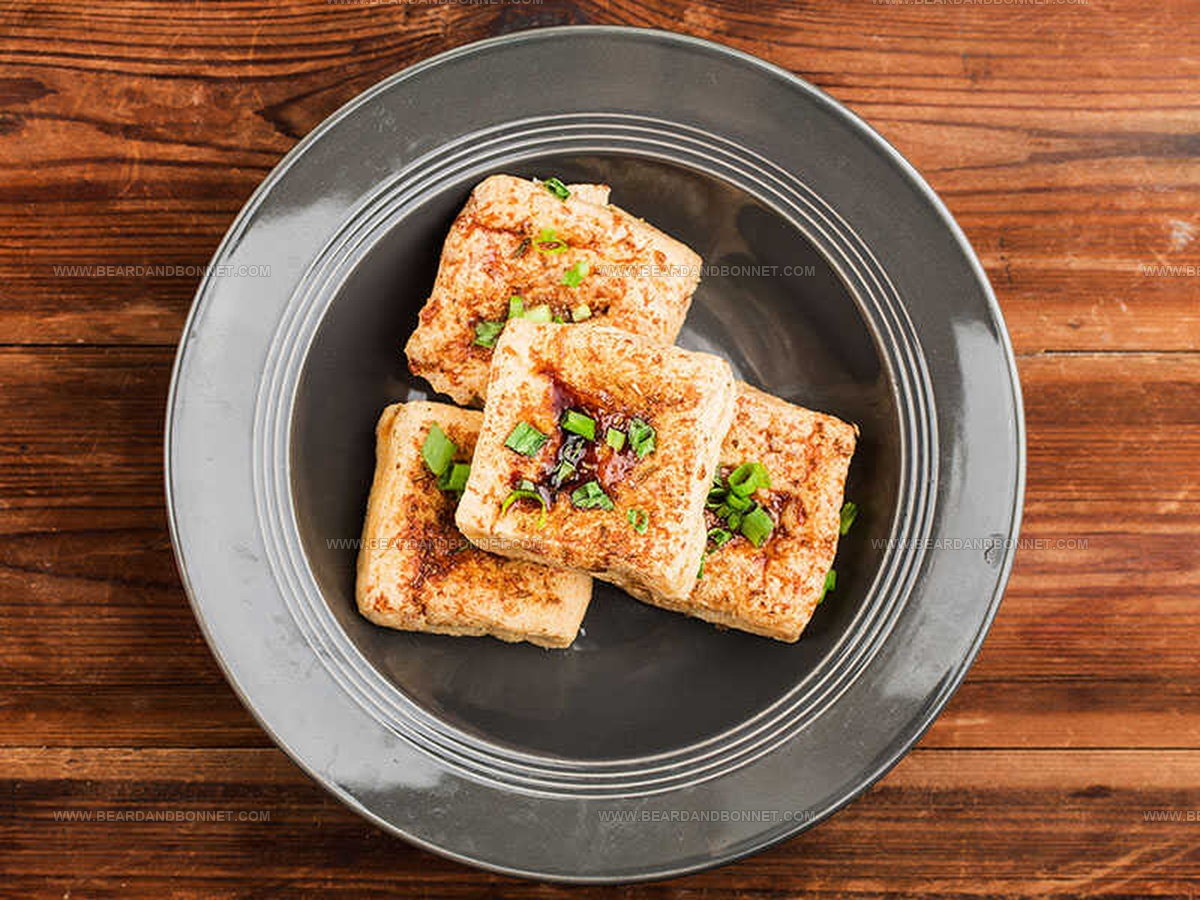
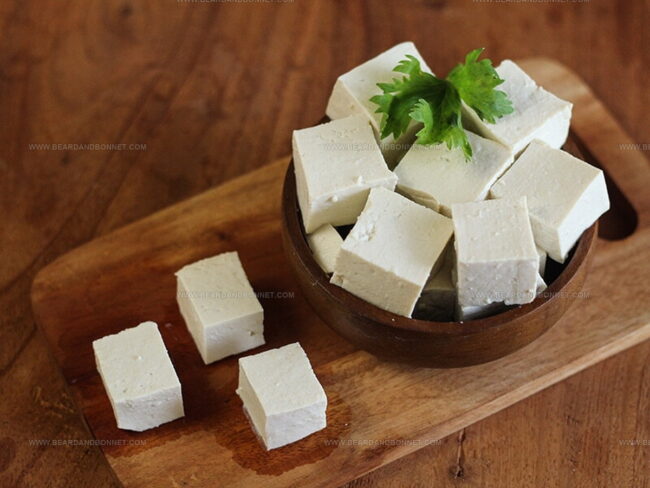
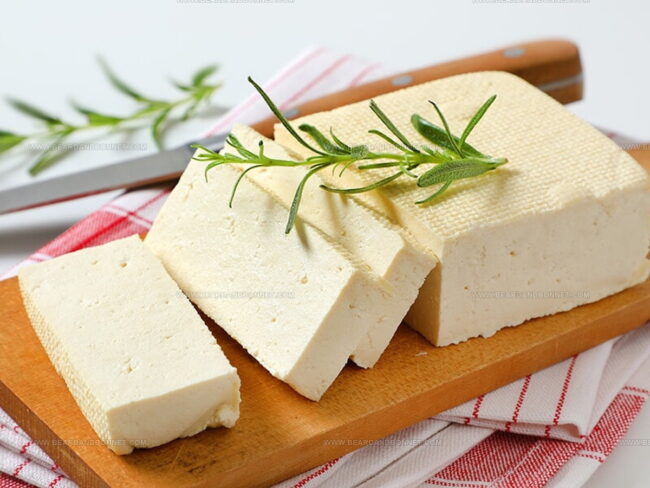
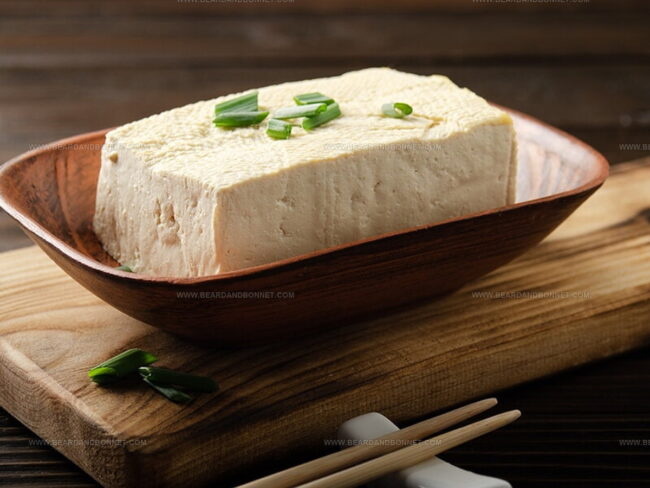
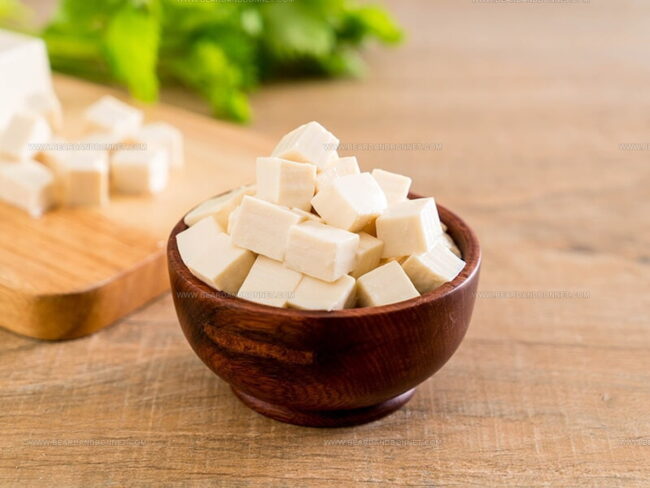
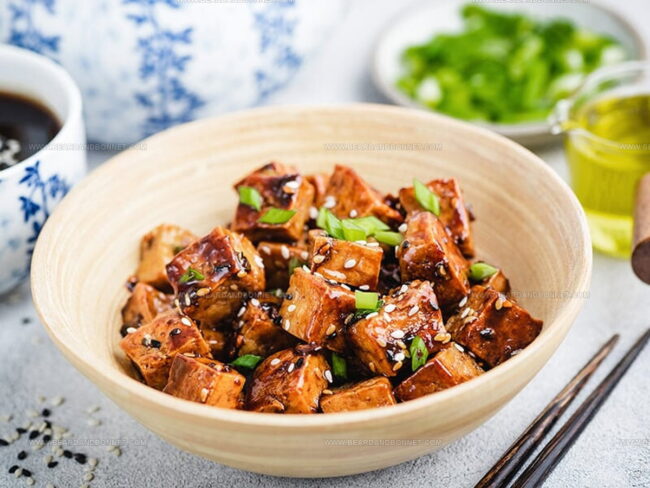
Jessica Martin
Recipe Developer & Food Writer
Expertise
Recipe Development, Food Styling and Photography, Seasonal and Local Ingredients, Vegetarian and Vegan Cuisine, Culinary Education
Education
Portland Community College
Oregon Culinary Institute
Jessica Martin is a talented food writer and recipe creator who specializes in seasonal cooking and approachable home baking.
Educated at Portland Community College with additional pastry training from Oregon Culinary Institute, Jessica’s culinary journey spans nearly a decade of creating and sharing flavorful recipes.
Her deep appreciation for local ingredients shapes each of her recipes, making them both accessible and inspiring. At Beard and Bonnet, Jessica uses her cheerful, down-to-earth writing to help readers effortlessly bring new tastes and creative dishes into their daily routines.